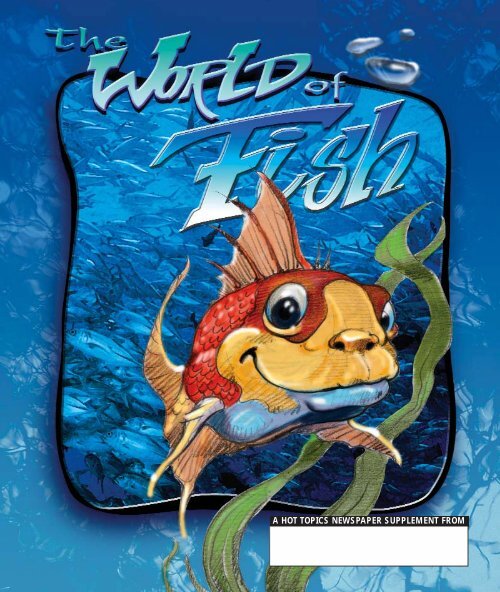a hot topics newspaper supplement from - Newspaper In Education
a hot topics newspaper supplement from - Newspaper In Education
a hot topics newspaper supplement from - Newspaper In Education
- No tags were found...
You also want an ePaper? Increase the reach of your titles
YUMPU automatically turns print PDFs into web optimized ePapers that Google loves.
A HOT TOPICS NEWSPAPER SUPPLEMENT FROM
Focus on Fish and FriendsFish are fabulous, fantastic, fascinating creatures thathave swum in our seas for more than500 million years. Some are fierce,some are fancy, some are finned, some are flashy, but allfish are fabulous. They belong to the group of animalscalled vertebrates, which means that they have a backboneand an internal skeleton made of bone or cartilage.They breathe under water using their gills and theymove around using their fins. Fish are cold-blooded,which means that their body temperatureis the same temperature asthe water around them. Somefish live in salt water, usuallyin the ocean. Others, orfreshwater fish, live in lakes, rivers,and streams.Fish make great pets. <strong>In</strong> fact, they’re the most popularpets in America, where there are about 108 million petfish. (There are about 68 million pet dogs, by the way.)Some people believe that watching fish is calming. That’s why you sometimes see fishtanks at dental offices – to help people relax. (Okay, it doesn’t explain why we seetanks at restaurants, but let’s not think about that.)The worlds in which fish live – the ocean, lakes, and rivers – arefilled with treasures. People work and play in these bodies of water, butmost of all, the water is home to millions of fish and othersea creatures.This special <strong>newspaper</strong> section will explore our fantasticfinned friends and the places they live. <strong>In</strong> reading this section, youwill be a person who studies fish – an ichthyologist (pronouncedIK-thee-ol-o-jist). Dive in!Get Hooked on the NewsLearning standard: skimming, writing poetry.21. Skim through the <strong>newspaper</strong> and make a list ofany words you see that you might be able to use ina poem about fish. Then write one.2. People who work on or near the water must keepa close eye on the weather. Check out the weatherinformation in your <strong>newspaper</strong> and see if it is goodfor working near the water.Credits:This Hot Topics <strong>supplement</strong> was:Written by Debby CarrollEdited by Ken BookmanDesigned by RoelIllustrated by Roelhttp://roelphantasm.com
Your Lake, River, and Ocean QuotientWhat Do You Know?What do you know about lakes, rivers, and oceans? Write answers to these questions, and whenyou’ve finished reading this special section, write new answers to see what you have learned.1. Name three types of animals that live in the ocean.a.b.c.2. What two things might you find if you walked along an ocean or lake on thebeach?a.b.3. If you tasted the ocean water, how would it taste?4. All rivers do this:a. Flow to an ocean.b. Flow to a lake.c. Run through a city.5. True or False? All lakes are small bodies of salt water.6. Lake Superior, the largest of the Great Lakes, also has the largestsurface area of any freshwater lake in the world. Its shoreline is:a. Almost 2,800 miles long.b. More than 4,000 miles long.c. Not able to be measured.7. The longest river in the UnitedStates is:a. The Mississippi.b. The Missouri.c. The Hudson.Sea RiddlesSolve these riddles about things that are found in theocean. Choose your answer <strong>from</strong> the list below.Remember that the correct answer will rhyme. Writeeach answer on the line1. I float on top of the ocean waves.My tentacles sting the food I crave.<strong>In</strong> spite of my name, you would not wishTo eat me with peanut butter. I’m aGet Hooked on theNewsLearning standard: summarizingCan you find any articles in the<strong>newspaper</strong> about bodies of water?Find one and write a summary of it.Answers to Quiz Questions:Questions 1 & 2 have many possibleanswers.# 3 Salty#4 a. flow to an ocean.#5 False.#6. a. almost 2800 miles long.#7. b. The MissouriAnswers:1. Jellyfish. 2. Crab. 3. Seaweed.2. I have claws I use for hands.As I crawl along the ocean sands.It’s easy for me to use claws to grab.When you see me, you call me3. Under the sea, there’s a forest of me,Growing, floating, swaying so free.The ocean knows I’m an important need.I’m a plant of the sea, known as.3
How People and Fish are AlikeYoung fish are a lot like you. You’re young.They’re young. You go to school. They goto school. But those are not the only waysthat you are like a young fish. Here are somefacts about how fish and people are the same.<strong>In</strong>side your body you have bones thatsupport you. Those bones are called yourskeleton. Fish are like you in that way. Theyhave skeletons to support them. Animals withskeletons are called vertebrates.People need oxygen to breathe,and so do fish. How can fish breatheunderwater if there is no air? Whenpeople go underwater, they have to take air intanks with them. How do the fish do it? Youbreathe using your lungs. You take oxygen <strong>from</strong> theair into yourbody. Fishbreathe usingtheir gills. Fishtake water intotheir mouths. Theytake oxygen <strong>from</strong> thewater into their bodies.After the waterhas been usedfor its oxygen,it passes out through thegills..4You need to sleep. When you go to sleep, you close your eyes.Fish don’t need sleep and that’s a good thing because they can’tclose their eyes. Why not? They don’t have eyelids. They dorest, however; they just don’t sleep. They just sort of daydream whilefloating, but they stay alert for any danger. What do you daydreamabout? Do you think fish might daydream about the same things youdo?
Food goes into your body through your mouth. Do you knowhow fish get food into their bodies? Just like you, they usetheir mouths. And just like you, fish can taste their food.But what’s really awesome is that fish may be able to taste foodbefore it gets into their mouths. Your taste buds are in yourmouth. Fish have taste buds in their mouths and on their bodies.It’s a good thing your taste buds are not on your body. Rubbingthat peanut butter and jelly sandwich on yourself at lunchwould make you really sticky for the rest of the day!You see with your eyes. Fish do, too. Some fish can’t see colorsso well, but fish can see clearly, even underwater. Have youever tried to open your eyes underwater?If you go swimming, you use your arms and legs. Well, fish don’t have armsand legs so how do they swim? They wiggle their bodies and tails <strong>from</strong> side toside. This moves them along through the water. They also have fins to helpthem keep their balance, to steer, and to stop. Most fish can’tswim backwards. Can you?You hear with the ears that are on the outside ofyour head. Fish ears are on the inside. Sound goesthrough the water into the fish’s body to the ears.You will probably live a nice long life of many years. Some fish willbe lucky, like you, and live for years. Sturgeons, for example, livepast 50. But others live only a few weeks.You walk and, believe it or not, there is afish that walks, too. The Climbing Perchof <strong>In</strong>dia is an amazing fish that canwalk on land in search of water when itswater hole dries up.Get Hooked on theNewsLearning standard: understanding thefive sensesFish and people have some of the samesenses, but not all. People have fivesenses – touch, taste, smell, hearing,and sight. Find a <strong>newspaper</strong> article thatrelates in some way to each sense..5
Wish You Knew Facts About Fish?Fish come in all shapes and sizes, <strong>from</strong> the huge whale shark, which can be 50 feet long and weighseveral thousand pounds, to the teeny Goby, which is just a few millimeters long.Here are some fun fish facts to know:Jellyfish really should be called water fish. They are more than90 percent water.Flounder are born with one eye on each side of the head.Slowly, one eye moves around the head and joins the other.Flying fish? Ye s, it’s true – mostly true, that is. These fish glideon the top of the water to get away <strong>from</strong> animals that may be chasing them underwater.They can stay in the air, going about 29 m.p.h. for about 20 seconds.There are more species (that is, varieties) of fish than of mammals, reptiles, and birdscombined – with more than 20,000 known fish species.Are fish on the endangered species list? They sure are. Fishare in serious trouble. <strong>In</strong> the United States, one-third of thefish species are in danger of being wiped out.Some fish can swim backward. They’re mostly the ones in theeel family and although they can do it, most of the time theychoose not to..6Fish don’t usually smell "fishy." They don’t get stinky untilthey are out of the water and start to rot.
No Bones About It– Sharks!Sharks have no bones. They are made up of cartilage, which isnot as hard as bone and is flexible.They do have unbelievably good eyesight, though. They cansee very well in dark areas – deep in the ocean, for example –because they have fantastic night vision. And, unlike other fish,sharks see colors easily, so if you go swimming near the sharks, don’twear a bright-colored bathing suit. And although sharks are famous fortheir scary eating habits, the fact is that sharks don’t even eat very often.Some can go for weeks or even months without eating.Get Hooked on the NewsLearning standard: identifying job opportunities1. Many people make their living on the water. Thereare people who operate boats, those who study fish,environmental protection workers, aquarium workers,and more. Can you find a job in the HelpWanted section that is related to water or fish insome way? Write a letter to that employer telling whyyou would be good for that job. If you think youwould not be good for that job, write a journal entrytelling why not.2. Some of the jobs related to fish and water require a science background.What other jobs listed are in a science-related field?.7
The Ocean Blue, Lakes, and Rivers, Too!We call our planet "Earth," but maybe we should call it "Water." After all, most of it is covered withwater. And most of that water is salt water. How did it get so salty?Salt and SandSome of the salt comes <strong>from</strong> volcanoes under the sea. Most of the salt comes <strong>from</strong> the land. Rain falls,and the salt in rocks gets washed into rivers. The rivers run down into the oceans, taking the salt withthem.Some fish are freshwater fish, andthey can live only in water thathas no salt. Other fish liveonly in salt water, so if they arekept in a fish tank, the water in thetank has to be salt water. Fish thatlive in tanks like these make greatpets, but they need clean saltwatertanks and those need to be treatedregularly.The Story of SandWhen river water flows over rocks, it breaks up the rocks into tiny pieces. Those tinypieces become the sand that you wiggle your toes in when you go to the beach..8And while you’re at the beach,you’ll see waves crashing ontothat sand. Thewaves swoop inand dump moresand on thebeach. But, then,as the waves flow back out,they carry some sand out into the ocean. The beachnever stays the same. It changes with each wave onits shore.
Freshwater FocusAcommunity of living things and their environment is called an ecosystem. The ocean is a saltwaterecosystem. Humans can’t drink salt water, though, so we live in a freshwater ecosystem. That means thatthe huge variety of plants, animals, insects, and all other living things that don’t live in the ocean or on adesert depend on fresh water to live.LakesLakes are at the center of a freshwater ecosystem. They aremade <strong>from</strong> underground springs, <strong>from</strong> snow melting <strong>from</strong> mountains,<strong>from</strong> rain, <strong>from</strong> streams that flow into them, and <strong>from</strong> acombination of all of those. Not all lakes have fish, but almost all arefreshwater. (The Great Salt Lake is an exception to this.) Lakes don’tflow or move. They are mostly still. They can be quite large, though.Consider the Great Lakes. They are so big that if all the water in theGreat Lakes were spread evenly across the continental United States,the ground would be covered with almost 10 feet of water. The largestof the Great Lakes is Lake Superior. Its shoreline is about 2,800 mileslong.RiversUnlike lakes that don’t really move much, rivers arefreshwater bodies that make their way to theocean. They are home to many types of fish andother animals, plants, and insects. Rivers are constantlychanging depending on weather and even on the oceantides. They are used for work, play, and even for transportation.Some rivers are dammed up to produce electricity, sorivers are also sources of power. Rivers come in all sizes. Thelongest one in North America is the Missouri River at 2,540miles. The longest river in the world is the Nile River inEgypt.Get Hooked on the NewsLearning standard: identifying habitats1. Check the comic strips in the <strong>newspaper</strong> and writedown the habitat of each of the characters in the strips.Make a graph showing how many different habitats arepictured.2. Some scientists worry that the waters of the earth arelosing some of their biodiversity, or variety of species. Thismay be due to global warming, or it could even be a resultof humans fishing for too many of some types of fish. Canyou find a story in the <strong>newspaper</strong> that shows a human whois helping or hurting the environment? Summarize it..9
The Great Barrier ReefDo you know what neighborhood you live in? A huge number of fish live in a fabulous neighborhood called"The Great Barrier Reef." It’s in the Pacific Ocean, off the coast of a country called Australia.Reefs are made <strong>from</strong> the skeletons of millions and millions of tiny sea creatures likecoral. The skeletons collect on top of each other and become something like bigapartment houses. The Great Barrier Reef is really a group of 2,800 coral reefs. Someparts are below the water and others are islands floating above the water.The Great Barrier Reef is the biggest natural feature on Earth. That means thatnature, not people, made it. It is home to thousands of animals, <strong>from</strong> the colorful spongeto the slithering serpent stars. From clownfish to sharks, the sea creatures that live in theGreat Barrier Reef aredifferent and beautiful.If coral reefs are like apartment houses,then you might think of the Great Barrier Reefas being like a big and exciting city with lots ofdifferent kinds of creatures in it. More than 1,500kinds, or species, of fish live there. New ones arefound every year. And fish aren’t the only animalsfound there. More than 215 different kinds of birdscall it home. Whales, worms, shellfish, and evensponges are found there. There are six differentkinds of sea turtles, too.The Great Barrier Reef istruly a natural wonder and atreasure that people on theEarth are lucky to have.Get Hooked on the NewsLearning standard: determining local, national andinternational.10News <strong>from</strong> the Great Barrier Reef would be consideredinternational news here in America because it is happeningon the other side of the world but is of interest here. Thatdiffers <strong>from</strong> local news which is only of interest where youlive and <strong>from</strong> national news which is of interest across ourcountry. Find one example of each type of news article inthe <strong>newspaper</strong>.
The Age of AquariumsIf you want to see how fish really live, think about visiting an aquarium – especially because, well, you can’tbreathe underwater. A visit to an aquarium gives you a fish’s eye view of the denizens of the deep. You can see howfish live <strong>from</strong> the ocean floor to the ocean shore and everywhere in between. Aquarium visitors learn all aboutaquatic life and the need to protect it.Imagine being able to dive 15 feet into the water to seewhat’s going on down there. That’s what you’ll feel like asyou walk by the aquarium tanks and peek into the glassto see a day in the life of fish. At some aquariums, you caneven touch the fish so you can feel their sliminess with yourown fingers.Chances are, no matter where you live, a public aquarium isn’t too far <strong>from</strong> you. <strong>In</strong> Bloomington, Minn.,Underwater Adventures is an aquarium under a mall. <strong>In</strong> Las Vegas, Nev., there’s a huge tank in a <strong>hot</strong>el. TheNational Aquarium in Baltimore, Md., features the Atlantic Coral Reef, home to some of the world’s most beautifuland dangerous fish. At the Florida Aquarium in Tampa Bay, beneath a shell-shaped dome, you’ll see stingraysglide, alligators hanging out, and river otters frolicking freely.Chicago offers the Shedd Aquarium at the city’s Art <strong>In</strong>stitute, so fish are bathed in beauty. On the Californiacoast, Monterey Bay Aquarium’s Otter Bay exhibit is a million-gallon tank overlooking the blue waters whereMonterey Bay meets the Pacific Ocean. The only aquarium in the country located on a living coral reef is inHonolulu’s Waikiki Aquarium. And across the country, at the New Jersey Aquarium, visitors can explore a West Africanexhibit and swim with sharks. The Mystic Aquarium in Connecticut offers a look at dolphins and an exploration of theTitanic, while the Seattle Aquarium lets visitors get face to fin. The Texas State Aquarium in Corpus Christi even letssome visitors help train dolphins.To find an aquarium near you, visithttp://www.aza.orgGet Hooked on theNewsLearning standard: skimmingPerhaps you have a local aquariumproviding education and entertainmentfor people in your area. What otherplaces can you find in your <strong>newspaper</strong>where people can go to be entertained?.11
ResourcesHere are some Web sites where you can read all about fish:http://www.seaworld.org/aquademics/tetra/all_about_fish.htm<strong>In</strong>formation about endangered fish species can be found at:www.endangered.fws.gov/wildlife.htmlA global database of fish is at:www.fishbase.org<strong>In</strong>formation about aquarium fish is at:www.aquariumfish.netLots of fish facts are at:www.nefsc.noaa.gov/faq/For fish facts and trivia, visit:www.indianchild.com/fish.htmJust for FunSmile as you read these popular fish funnies.Q. What do you call a fish without eyes?A. Fsh.Two lobsters were on a date. The boylobster went to buy an ice cream coneand ate it without offering any to hisfriend. She said, "You shellfish creep,"and left.Q. Why are fish so smart?A. They travel in schools.Q. What did the fish say to the beach?A. Nothing. It just waved.Q. How does a fish call its mother?A. With a shellular phone.Q. What do you get if you cross an elephant with a fish?A. Swimming trunks..12Q. Where do fish keep their money?A. <strong>In</strong> riverbanks.




